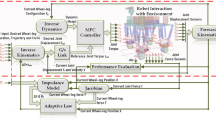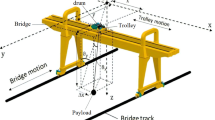Abstract
Crawler excavators are important, utilitarian machines in construction industries. Special features of the chain and chassis allow them to operate and move on unstable ground. The shock motions of the links, which coincide with the changes of the forces impacting the foundation, create vibrations within the entire system. The highest level of vibrations appears when the boom moves, as it holds the robotic excavator's entire actuator with large mass and moment of inertia. These undesired fluctuations cause system instability, driver discomfort, reduced operating efficiency, and increased energy consumption. In this study, a hierarchical sliding mode control focusing on boom movement is designed based on the system dynamic model. This controller allows the boom to move precisely with a slight fluctuation angle of the main body, even while the other links are moving using a parameter estimator. Maintaining stable boom movements significantly simplifies arm and bucket control. The effectiveness of the entire work is investigated by numerical simulation and implementation results on a small-scale hydraulic excavator.





















Similar content being viewed by others
Abbreviations
- \(m_{1}\) :
-
Mass of the main body
- \(m_{2}\) :
-
Mass of the boom
- \(m_{3}\) :
-
Mass of the arm
- \(m_{4}\) :
-
Mass of the bucket
- \(I_{1z}\) :
-
Moment of inertia of the body about the axis perpendicular to the work plane and passing through \(O_{1}\)
- \(I_{2z}\) :
-
Moment of inertia of the boom the axis perpendicular to the work plane and passing through \(O_{2}\)
- \(I_{3z}\) :
-
Moment of inertia of the arm the axis perpendicular to the work plane and passing through \(O_{3}\)
- \(I_{4z}\) :
-
Moment of inertia of the bucket the axis perpendicular to the work plane and passing through \(O_{4}\)
- \(b_{1}\) :
-
Damping coefficients of body motion
- \(b_{2}\) :
-
Damping coefficients of boom motion
- \(g\) :
-
Gravitational acceleration
- \(a_{1}\) :
-
Length of the body
- \(a_{2}\) :
-
Length of the boom
- \(a_{3}\) :
-
Length of the am
- \(a_{4}\) :
-
Length of the bucket
- \(\delta_{\alpha } \left( t \right)\) :
-
Controlled angle of the body
- \(\beta \left( t \right)\) :
-
Controlled angle of the boom
- \(\gamma \left( t \right)\) :
-
Controlled angle of the arm
- \(\theta \left( t \right)\) :
-
Controlled angle of the bucket
- \(a_{c1}\) :
-
Distance from the origin to the mass center of the body
- \(a_{c2}\) :
-
Distance from the origin to the mass center of the boom
- \(a_{c3}\) :
-
Distance from the origin to the mass center of the arm
- \(a_{c4}\) :
-
Distance from the origin to the mass center of the bucket
- \(\varphi_{1}\) :
-
Fixed angle in the body related to the position of the mass center
- \(\varphi_{2}\) :
-
Fixed angle in the boom related to the position of the mass center
- \(\varphi_{3}\) :
-
Fixed angle in the arm related to the position of the mass center
- \(\varphi_{4}\) :
-
Fixed angle in the bucket related to the position of the mass center
- \(K_{eq}\) :
-
Equivalent stiffness of the foundation
- \(S_{\alpha }\) :
-
Abbreviation of \(\sin \alpha\)
- \(C_{\alpha }\) :
-
Abbreviation of \(\cos \alpha\)
- \(S_{\alpha \beta }\) :
-
Abbreviation of \(\sin (\alpha + \beta )\)
- \(C_{\alpha \beta }\) :
-
Abbreviation of \(\cos (\alpha + \beta )\)
- \(T\), \(\Pi\) :
-
Kinematic and potential energy of the system
References
Xu, B., Cheng, M., Yang, H., Zhang, J., & Sun, C. (2015). A hybrid displacement/pressure control scheme for an electrohydraulic flow matching system. IEEE/ASME Transactions Mechatronics, 20(6), 2771–2782.
Tuan, L. A., Lee, S.-G., Dang, V.-H., Moon, S., & Kim, B. (2013). Partial feedback linearization control of a three-dimensional overhead crane. International Journal of Control, Automation and Systems, 11(4), 718–727.
Tuan, L. A., & Lee, S.-G. (2018). Modeling and advanced sliding mode controls of crawler cranes considering wire rope elasticity and complicated operations. Mechanical Systems and Signal Processing, 103, 250–263.
Tuan, L., Cuong, H., Lee, S.-G., Nho, L., & Moon, K. (2014). Nonlinear feedback control of container crane mounted on elastic foundation with the flexibility of suspended cable. Journal of Vibration and Control, 22, 3067–3078.
Tuan, L. A., Kim, J.-J., Lee, S.-G., Lim, T.-G., & Nho, L. C. (2014). Second-order sliding mode control of a 3d overhead crane with uncertain system parameters. International Journal of Precision Engineering and Manufacturing, 15(5), 811–819.
Le, A. T., & Lee, S.-G. (2017). 3D cooperative control of tower cranes using robust adaptive techniques. Journal of the Franklin Institute, 354(18), 8333–8357.
Tuan, L. A., Lee, S.-G., Nho, L. C., & Cuong, H. M., 2015, “Robust Controls for Ship-Mounted Container Cranes with Viscoelastic Foundation and Flexible Hoisting Cable,” Proc. Inst. Mech. Eng. Part I J. Syst. Control Eng., 229(7), pp. 662–674.
Tran, D.-T., Do, T.-C., & Ahn, K.-K. (2019). Extended high gain observer-based sliding mode control for an electro-hydraulic system with a variant payload. International Journal of Precision Engineering and Manufacturing, 20(12), 2089–2100.
Tuan, L. A., Lee, S.-G., Nho, L. C., & Kim, D. H. (2013). Model reference adaptive sliding mode control for three dimensional overhead cranes. International Journal of Precision Engineering and Manufacturing, 14(8), 1329–1338.
Deepika, D., Narayan, S., & Kaur, S. (2019). Globally robust adaptive critic based neuro-integral terminal sliding mode technique with UDE for nonlinear systems. International Journal of Precision Engineering and Manufacturing, 21, 403–414.
Fang, J., Zhang, L., Long, Z., & Wang, M. Y. (2018). Fuzzy adaptive sliding mode control for the precision position of piezo-actuated nano positioning stage. International Journal of Precision Engineering and Manufacturing, 19(10), 1447–1456.
Pham, D. B., & Lee, S.-G. (2018). Aggregated hierarchical sliding mode control for a spatial ridable ballbot. International Journal of Precision Engineering and Manufacturing, 19(9), 1291–1302.
Pham, D. B., Kim, J., Lee, S.-G., & Gwak, K.-W. (2019). Double-loop control with hierarchical sliding mode and proportional integral loop for 2D ridable ballbot. International Journal of Precision Engineering and Manufacturing, 20(9), 1519–1532.
Acknowledgements
This research was partly supported by the National Research Foundation of Korea funded by the Ministry of Education (2019R1A2C2010195) and by the Ministry of Science and ICT, Korea, under the ICT Consilience Creative program (IITP-2019-2015-0-00742) supervised by the IITP. Besides, the work was supported by Ministry of Trade, Industry and Energy under Robot Industrial Core Technology Development Project program (K_G012000921401) supervised by the KEIT and by the LIG Nex1 Co., Ltd., through the Development of Multi-Platform Interlocking Control Model and Control Algorithm Program of the Agency for Defense Development (ADD) of Korea under Grant 20192610. It was also supported by Vietnam Maritime University.
Author information
Authors and Affiliations
Corresponding author
Additional information
Publisher's Note
Springer Nature remains neutral with regard to jurisdictional claims in published maps and institutional affiliations.
Appendix
Appendix
The Jacobian matrix for translation of the ith link is given as follows:
where
Rights and permissions
About this article
Cite this article
Hoang, QD., Park, JG., Lee, SG. et al. Aggregated Hierarchical Sliding Mode Control for Vibration Suppression of an Excavator on an Elastic Foundation. Int. J. Precis. Eng. Manuf. 21, 2263–2275 (2020). https://doi.org/10.1007/s12541-020-00422-9
Received:
Revised:
Accepted:
Published:
Issue Date:
DOI: https://doi.org/10.1007/s12541-020-00422-9




